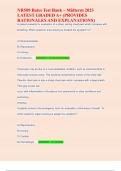Resume
Summary Pediatric Infectious Diseases & Immunity part 2: Immune deficiencies and vaccinations
- Cours
- Établissement
Summary of the lectures (HC, WG, ...) and the presentations given during part 2 of MED-MIN23: Pediatric Infectious Diseases & Immunity.
[Montrer plus]












